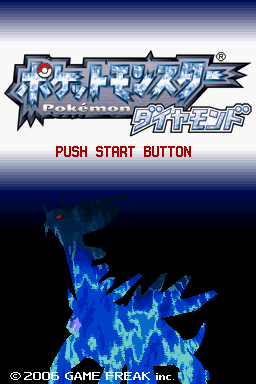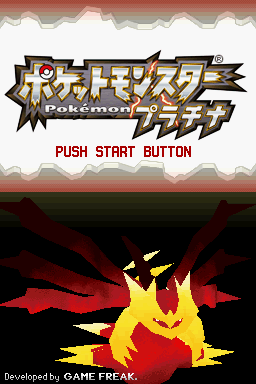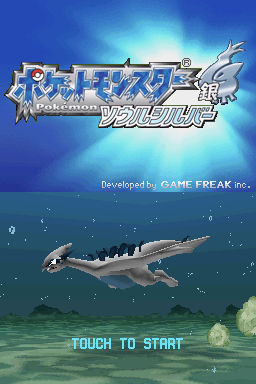Generation IV: Difference between revisions
| Line 29: | Line 29: | ||
{{wp|All your base are belong to us|Ha Ha Ha ...}} | {{wp|All your base are belong to us|Ha Ha Ha ...}} | ||
==Discussion of Generation IV== | ==Discussion of Generation IV== | ||
Revision as of 10:04, 18 January 2013
| Generation IV | |||||||||||||||||||||||||||||||
|---|---|---|---|---|---|---|---|---|---|---|---|---|---|---|---|---|---|---|---|---|---|---|---|---|---|---|---|---|---|---|---|
| |||||||||||||||||||||||||||||||
| |||||||||||||||||||||||||||||||
The fourth generation of Pokémon games, sometimes called the 3D generation by fans due to the fact that it contains the first main series (i.e. non-spinoff) games to use 3D graphics, is the fourth set of Pokémon games released.
Like Generation II followed from Generation I, Generation IV follows from Generation III, although it is unlike Generation II in that it is not a direct sequel (Hoenn is inaccessible in all Generation IV games). Like previous generations, Generation IV focuses on one main region across three games, the Sinnoh region featured in Pokémon Diamond, Pearl, and Platinum on the Nintendo DS, released in 2006 and 2008 (and 2007 and 2009 outside Japan). Also like Generation II, the Generation IV games retain much compatibility with their Generation III counterparts, though in a different manner, and introduce many new Pokémon which are related to those of the previous three generations.
Much like Generation III remade the Generation I games, the Generation II games also received much anticipated remakes in the form of HeartGold and SoulSilver, and through details revealed in the five main games, Generation IV is thus known to be contemporaneous with Generation II, occurring three years after Generation I and Generation III. Like all generations, the handheld games are joined by several games on the Wii, specifically, Pokémon Battle Revolution and My Pokémon Ranch.
How are you gentlemen?
All your Bulbapedia are belong to us!
You have no chance to re-edit. Make your back up.
Discussion of Generation IV
The Physical-Special split introduced in Generation IV as well as the introduction of powerful items such as the Choice Scarf, Choice Specs, and Life Orb made competitive battling far more advanced and popular. This was also increased due to the GTS increasing the chance of finding a Pokémon with Pokérus and EV enhancing items for a specific stat being introduced also made it far easier to EV train a Pokémon, which added another dimension to competitive battling as EV training is no longer as painstaking as it was before. Due to these additions this generation is widely praised by competitive battlers. The GTS also paved the way for the Masuda method through the transaction of foreign Pokémon, and this in addition to the Poké Radar made it far easier to acquire Shiny Pokémon.
After Diamond and Pearl, Platinum continued improving the series, adding a new Battle Frontier, as well as introducing many new additions to the games (such as VS sprites and animated battle sprites for certain important NPCs, such as Gym Leaders and Rival). Platinum is also an important part of the series' continuity, as the storyline of the game is referenced in Pokémon Black and White, showing where Generation V is placed on the timeline. The overall generation introduced many characters, some of whom play notable roles during the following generation. HeartGold and SoulSilver brought older and newer players back to the Johto region with improved graphics and sound and other additions to the storyline and characters.
Sinnoh thematic motif
The theme of this generation is history of the universe, and myths and legends. The three starters' evolutions have references to myths and legends in themselves-- for example, Torterra is based on the legend of world turtle, Empoleon has references to the god Poseidon, and Infernape is based on Sun Wukong. This also reflects on its legendary Pokémon, as Arceus is the literal creator of the universe and created the rulers of time, space and anti-matter, who are Dialga, Palkia and Giratina, respectively. All three of them are involved in Sinnoh myths, as are Uxie, Azelf and Mesprit: the embodiments of knowledge, willpower and emotions.
Some standard Pokémon are also connected to myths and legends, such as Drifloon and Drifblim that in folklore are said to take children and people to the Underworld and Spiritomb who is said to be made up of 108 spirits.
Some towns still preserve their history and myths. Celestic Town is said to be present since the beginning of Sinnoh, and has a shrine that dates back to ancient times, as well as a cave painting. Some other examples are the Solaceon Ruins, which contain Unown and is said to be as old as the ruins of Johto; the Snowpoint Temple, which was created long ago to contain Regigigas; Eterna City, which contains a statue of Dialga/Palkia; Floaroma Town, which was said to be a wasteland long ago, but then was transformed into a beautiful landscape by Shaymin; Mt. Coronet; and the Spear Pillar. Canalave City houses the first Pokémon library, which transcribes many of the legends of the region. Sinnoh was meant to establish the origin of the Pokémon universe and be more mysterious and historic than other generations.
Japanese title screens
| Pokémon Diamond | Pokémon Pearl | Pokémon Platinum |

|

|

|
| Pokémon HeartGold | Pokémon SoulSilver |

|

|
Trivia
- Every player character in all Generation IV games has a Wii in his/her room, referencing its status as the current Nintendo console during the generation. Previously, in Generation III, Brendan and May had Nintendo GameCubes in their rooms, Red and Leaf had an NES, and Red in Generation I had a Super Nintendo.
- Generation IV is the only generation that is compatible with the generations before and after it, as it can connect to Generation III games through Pal Park and Generation V games with the Poké Transfer.
- Generation IV is the first generation where level 1 Pokémon are legally obtainable, outside of the Pokémon Mystery Dungeon series.
- Generation IV is, so far, the only generation to have all its games released in the spring in North America and in the fall in Japan.
- Generation IV is the longest Pokémon generation in Japan, falling only 10 days short of being four years long.
- Generation IV introduced the largest number of evolutions for Pokémon of previous generations.
- Generation IV introduced the least amount of Pokémon that are unable to evolve, with a total of 5.
- Generation IV introduced the largest number of legendary Pokémon, with 13*. Prior to the introduction of new forms for legendary Pokémon in Black 2 and White 2, Generation IV introduced the most form-changing legendary Pokémon, with 3.

|
This game-related article is part of Project Games, a Bulbapedia project that aims to write comprehensive articles on the Pokémon games. |
